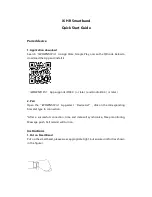
20
Additional Information
Warning Messages
If there is something wrong with the input signal, one of the
following messages appears.
The message disappears after about 30 seconds.
Additional Information
1
The input signal condition
“OUT OF SCAN RANGE”
indicates that the input signal
is not supported by the monitor’s specifications.
“NO INPUT SIGNAL”
indicates that no signal is input, or
the input signal from the selected input connector is not
received.
2
The selected input connector
Indicates which input connector is receiving the wrong
signal. If there is something wrong with the signal from
both input connectors, “HD15” and “BNC” are
displayed alternately.
To solve these problems, see “Troubleshooting” below.
Troubleshooting
This section may help you isolate the cause of a problem and as a result, eliminate the need to contact technical support.
Symptom
Check these items
No picture
If the
u
indicator is not lit
If the “NO INPUT SIGNAL”
message appears on the
screen, or if the
u
indicator is
either orange or alternating
between green and orange
If the “OUT OF SCAN
RANGE” message appears on
the screen
If no message is displayed
and the
u
indicator is green
or flashing orange
If using a Macintosh system
If using Windows
®
95
Picture is scrambled
• Check that the power cord is properly connected.
• Check that the
u
(power) switch is in the “on” position.
• Try pressing any key on the computer keyboard.
• Check that your computer power switch is in the “on” position.
• Check that the input select setting is correct.
• Check that the video signal cable is properly connected and all plugs are firmly seated
in their sockets.
• Check that the 5 BNCs are connected in the correct order (from left to right: Red–
Green–Blue–HD–VD) (page 6).
• Ensure that no pins are bent or pushed in the HD15 video input connector.
• Check that the video board is completely seated in the proper bus slot.
• Check that the video frequency range is within that specified for the monitor.
(Horizontal: 30 – 92 kHz, Vertical: 48 – 160 Hz)
Refer to your computer‘s instruction manual to adjust the video frequency range.
• If you are using a video signal cable adapter, check that it is correct.
• See “Self-diagnosis Function” (page 22).
• Check that the Macintosh adapter and the video signal cable are properly connected
(page 6).
• If you cannot find “GDM-200PS” among the Sony monitors in the Windows 95
monitor selection screen, select the DDC standard monitor or install the Windows 95
Monitor Information Disk (page 7).
The DDC standard does not apply to the 5 BNC connectors. If you use the DDC
standard, connect the computer to the HD15 connector with the supplied video signal
cable.
• Check your graphics board manual for the proper monitor setting.
• Check this manual and confirm that the graphics mode and the frequency you are
trying to operate at is supported. Even if the frequency is within the proper range,
some video boards may have a sync pulse that is too narrow for the monitor to sync
correctly.
INFORMATION
OUT OF SCAN RANGE
INPUT : HD15
21
Getting Started
Additional Information
F
EN
ES
C
Symptom
Check these items
Color is not uniform
You cannot adjust the
monitor with the buttons on
the front panel
White does not look white
Screen image is not centered
or sized properly
Edges of the image are
curved
White lines show red or blue
shadows at edges
Picture is fuzzy
Picture bounces or has wavy
oscillations
Picture is flickering
Picture appears to be
ghosting
Wavy or elliptical (moire)
pattern is visible
Two fine horizontal lines
(wires) are visible
Hum is heard right after the
power is turned on
• Degauss the monitor (page 15).
If you place equipment which generates a magnetic field, such as a loudspeaker, near
the monitor, or you change the direction of the monitor, color may lose uniformity.
The degauss function demagnetizes the metal frame of the CRT to obtain a neutral
field for uniform color reproduction. If a second degauss cycle is needed, allow a
minimum interval of 20 minutes for the best result.
• If the control lock function is set to on, set it to off using the OPTION OSD (page 16).
• Adjust the color temperature (page 13).
• Check that the 5 BNCs are connected in the correct order (from left to right: Red–
Green–Blue–HD–VD) (page 6).
• Adjust the size or centering (page 11).
• Some video modes do not fill the screen to the edges. This problem tends to occur with
certain video boards.
• Adjust the geometry (page 12).
• Adjust the convergence (page 14).
• Adjust the contrast and brightness (page 9).
• Degauss the monitor (page 15).
If you place equipment which generates a magnetic field, such as a loudspeaker, near
the monitor, or you change the direction of the monitor, color may lose uniformity.
The degauss function demagnetizes the metal frame of the CRT to obtain a neutral
field for uniform color reproduction. If a second degauss cycle is needed, allow a
minimum interval of 20 minutes for the best result.
• If red or blue shadows appear along the edges of images, adjust the convergence (page
14).
• If the moire is cancelled, the picture may become fuzzy. Decrease the moire
cancellation effect (page 14).
• Isolate and eliminate any potential sources of electric or magnetic fields. Common
causes for this symptom are electric fans, fluorescent lighting or laser printers.
• If you have another monitor close to this monitor, increase the distance between them
to reduce the interference.
• Try plugging the monitor into a different AC outlet, preferably on a different circuit.
• Try the monitor on a different computer in a different room.
• Set the refresh rate on the computer to obtain the best possible picture by referring to
your computer’s manual.
• Eliminate the use of video cable extensions and/or video switch boxes if this symptom
occurs. Excessive cable length or a weak connection can produce this symptom.
• Cancel the moire (page 14).
The moire may be modified depending on the connected computer.
• Due to the relationship between resolution, monitor dot pitch and the pitch of some
image patterns, certain screen backgrounds sometimes show moire. Change your
desktop pattern.
• These wires stabilize the vertically striped aperture grille (page 19). This aperture grille
allows more light to pass through to the screen giving the Trinitron CRT more color
and brightness.
• When the power is turned on, the auto-degauss cycle is activated. While the auto-
degauss cycle is activated, a hum may be heard. The same hum is heard when the
monitor is manually degaussed. This is not a malfunction.
1-6











































